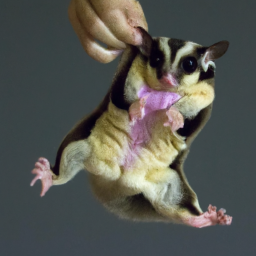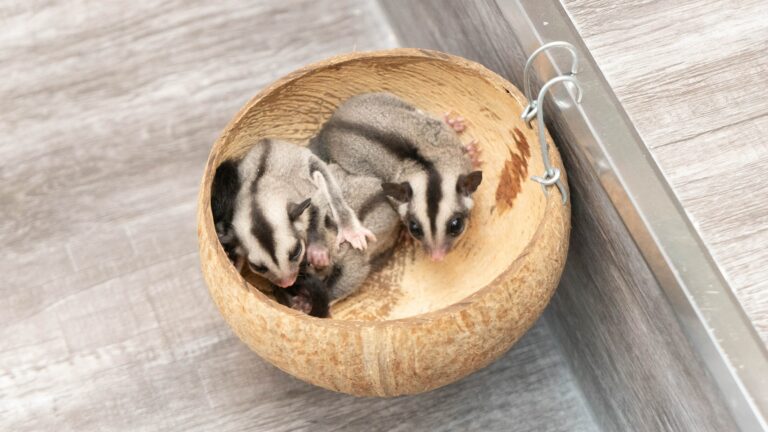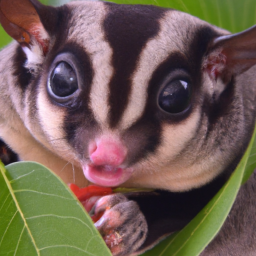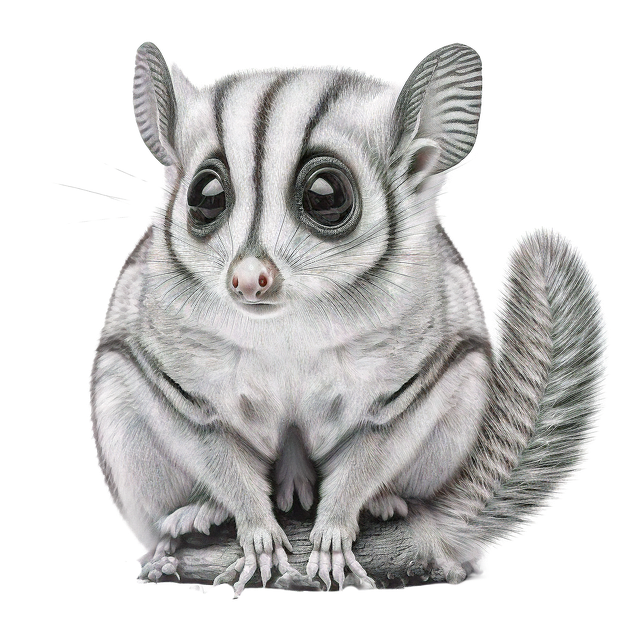Types Of Sugar Gliders
Hello! In this article, we will be discussing the various types of sugar gliders. You will learn about the different species and subspecies of sugar gliders, as well as their unique characteristics and appearances. We will also explore their natural habitats and distribution across different regions. By the end of this article, you will have a better understanding of the diverse types of sugar gliders that exist. So, let’s get started!
Types Of Sugar Gliders
Are you fascinated by the unique and adorable Australian marsupials known as sugar gliders? These small creatures are known for their acrobatic movements and gliding abilities, as well as their charming appearance. In this article, we will explore the different types of sugar gliders, their physical characteristics, habitat and distribution, diet and feeding habits, social behavior, reproduction and lifecycle, predators and defense mechanisms, human interaction and pet ownership, health concerns and veterinary care, and conservation status and efforts. So, let’s dive in and learn more about these captivating creatures!
Physical Characteristics
Fur and Color Variations
Sugar gliders have soft, dense fur that comes in various color variations. The most common coloration is grey with a black stripe running from their head to their tail, giving them a distinctive appearance. However, sugar gliders can also have color variations such as albino and leucistic, where their fur lacks pigmentation and appears white or pale. Additionally, there are also sugar gliders with rare colorations like caramel, platinum, and mosaic, which are highly sought after by enthusiasts.
Body Size and Shape
On average, sugar gliders measure about 5 to 6 inches in length, excluding their tail. Including the tail, they can reach up to 12 inches in total length. These petite creatures have a slender body shape, allowing them to glide effortlessly through the treetops. Their tails are semi-prehensile, meaning they can grip onto branches and provide stability during their aerial adventures.
Glider-like Patagium
One distinctive feature of sugar gliders is their patagium, a thin, furry membrane of skin that stretches between their wrists and ankles. This unique adaptation enables them to glide for impressive distances, reaching up to 150 feet in a single glide. Their patagium acts as wings, allowing them to maneuver through the air and glide between trees as they search for food and explore their surroundings.
Large Eyes and Ears
Sugar gliders have large, round eyes that provide them with excellent vision, particularly in low-light conditions. Their eyes are adapted for nocturnal activity, helping them spot potential predators or locate sources of food during the night. Additionally, these marsupials have large ears with sensitive hearing, allowing them to detect even the faintest of sounds. Their acute hearing helps them navigate in their environment and communicate with fellow gliders.
Habitat and Distribution
Native Habitats
Sugar gliders are native to the forests of Australia, where they inhabit various types of environments, including tropical rainforests, eucalyptus forests, and woodlands. These habitats provide them with the necessary resources, such as tree hollows for nesting and a diverse range of food sources.
Natural Distribution
Within Australia, sugar gliders can be found in the eastern and northern regions, spanning from the eastern coast of Queensland to the southwestern region of Western Australia. Their distribution covers a wide range of geographical areas, including both coastal and inland habitats.
Introduced Populations
In recent years, sugar gliders have been introduced to other parts of the world, including parts of Asia, Europe, and the United States. These introductions have primarily occurred through the pet trade, where these charming marsupials have gained popularity as exotic pets. While some of these introduced populations have successfully established themselves, it is important to note that keeping sugar gliders as pets requires responsible ownership and adherence to local regulations.
Preferred Nesting Sites
Sugar gliders are arboreal creatures, meaning they spend most of their lives in trees. They have a preference for nesting in tree hollows, which provide them with shelter and protection from predators. These tree hollows serve as their primary nesting sites, where they create cozy nests lined with leaves, bark, and other soft materials.
Diet and Feeding Habits
Omnivorous Diet
Sugar gliders have an omnivorous diet, meaning they consume a variety of foods from both plant and animal sources. Their diet consists of fruits, nectar, sap, insects, and small vertebrates. This versatility in their feeding habits allows them to adapt to different food availability in their natural habitats.
Feeding on Nectar and Sap
One notable aspect of their diet is their fondness for nectar and sap. Sugar gliders have a long, brush-like tongue that helps them lap up sweet nectar from flowers, providing them with a quick energy boost. They also have sharp incisors that allow them to gnaw into tree bark and access the nutritious sap inside.
Predation on Insects and Small Vertebrates
While sugar gliders primarily rely on plant-based foods, they also possess sharp teeth and claws that enable them to capture and consume small insects and vertebrates. These prey items serve as a source of protein in their diet, providing them with essential nutrients for their overall health and vitality.
Seed and Fruit Consumption
Sugar gliders play a crucial role in seed dispersal within their ecosystems. As they feed on fruits, they inadvertently consume seeds, which they later disperse as they move and excrete waste. This process contributes to the regeneration and biodiversity of their habitats, making them essential contributors to their ecosystems.
Social Behavior
Colonial Nesting
Sugar gliders are social animals that exhibit colonial nesting behaviors. They live in small family groups known as colonies, typically consisting of an adult breeding pair and their offspring. These colonies often share a nest and engage in various social interactions, such as grooming, playing, and sleeping together.
Bonding and Grooming
Within a sugar glider colony, individuals form strong bonds with their group members. They engage in grooming behaviors, where they maintain the cleanliness of their fur and establish social bonds by grooming each other. This grooming ritual not only ensures hygiene but also promotes social cohesion within the colony.
Scent Marking and Vocalizations
Sugar gliders communicate through various means, including scent marking and vocalizations. They have scent glands on their heads and chests, which they use to mark their territory and communicate with other gliders. Additionally, they produce a range of vocalizations, including barks, chirps, and clicks, to convey different messages and express their emotions.
Hierarchy and Social Structure
Within a sugar glider colony, a hierarchical structure exists, with dominant individuals having priority access to resources and preferred nesting sites. This hierarchy is determined through specific behaviors, such as posturing, vocalizations, and physical interactions. The social structure of sugar gliders allows for cooperation and division of labor within the colony.
Reproduction and Lifecycle
Mating and Breeding Season
Sugar gliders have a well-defined mating and breeding season, typically occurring during the spring and summer months. During this time, males will compete for the attention of females through vocalizations and physical displays. Once a pair bonds, they will mate, and the female will become pregnant.
Gestation Period
The gestation period of sugar gliders is relatively short, lasting around 16 to 17 days. After mating, the female will develop a pouch in her abdomen, where she will carry and nurture her developing young.
Birth and Pouch Development
After the gestation period, the female will give birth to tiny, underdeveloped joeys, which measure about 1 centimeter in length. The joeys will immediately crawl into their mother’s pouch, where they will continue to develop and grow for several weeks. During this time, the mother will provide them with milk and constant care.
Weaning and Independence
Around 70 to 80 days after birth, the joeys will start to emerge from their mother’s pouch and explore their surroundings. They will continue to nurse for a few more weeks before gradually weaning off their mother’s milk. Once fully independent, the young gliders will leave the colony to establish their territories and form their own breeding groups.
Predators and Defense Mechanisms
Natural Predators
Sugar gliders face predation from a variety of natural predators in their native habitats. These include owls, snakes, goannas, and large birds of prey. These predators pose a significant threat to sugar gliders, particularly during their vulnerable moments, such as when they are gliding or nesting.
Camouflage and Stealth
To enhance their chances of survival, sugar gliders have developed camouflage as a defense mechanism. Their gray fur blends well with the tree bark and foliage, making them less visible to predators. In addition, their small size and agile movements allow them to move stealthily through the treetops, reducing the risk of detection.
Defensive Sounds and Behaviors
When threatened, sugar gliders can produce defensive sounds and behaviors to deter predators. They may emit a loud bark or hiss to startle potential threats, showcasing their readiness to defend themselves. Additionally, they can engage in rapid or erratic movements, making it harder for predators to capture them.
Group Defense Strategies
Within a sugar glider colony, individuals engage in collective defense strategies to protect themselves from predators. When a predator is detected, gliders can emit vocal alarm calls, alerting their colony members and influencing them to join in defense. By gathering in groups and using their combined strength, sugar gliders have a higher chance of warding off potential threats.
Human Interaction and Pet Ownership
Legal Restrictions
As charming as sugar gliders may be, it is important to note that they are not legal to own as pets in all areas. Various countries and states have specific regulations regarding the ownership of sugar gliders, primarily due to concerns about their welfare and ecosystem impacts if released or escaped into the wild. Before considering sugar gliders as pets, it is essential to research and adhere to the legal restrictions in your area.
Responsibilities and Care
If you are considering owning a sugar glider as a pet, it is crucial to understand the responsibilities and care required. Sugar gliders are social animals that require daily interaction, mental stimulation, and a suitable environment that mimics their natural habitat. They need a specifically balanced diet, regular veterinary check-ups, and proper hygiene maintenance to ensure their well-being. Owning a sugar glider requires commitment and dedication to provide the best possible care for these unique creatures.
Behavioral Considerations
Sugar gliders exhibit natural behaviors such as gliding, climbing, exploring, and socializing. As a pet owner, it is vital to provide ample opportunities for these behaviors to be expressed. This includes providing a spacious and enriching enclosure, engaging in interactive play, and allowing supervised time outside of their enclosures for exercise. Understanding their natural instincts and needs will contribute to their overall happiness and quality of life.
Bonding and Socialization
Sugar gliders can form strong bonds with their human owners through regular handling, positive interactions, and bonding exercises. Building trust and a secure relationship with your pet glider is crucial for their well-being. It is important to note that sugar gliders are highly social animals, and their need for social interaction should be respected. Considering owning multiple gliders can provide them with companionship and a sense of belonging.
Health Concerns and Veterinary Care
Common Health Issues
Sugar gliders, like any other pets, can encounter health issues and ailments. Some common health concerns in sugar gliders include nutritional deficiencies, dental problems, gastrointestinal issues, and parasitic infections. Regular veterinary check-ups and consultation with an experienced veterinarian knowledgeable in sugar glider care are essential for maintaining their health and addressing any potential issues promptly.
Proper Diet and Nutrition
Providing a nutritionally balanced diet is crucial for the well-being of sugar gliders. A combination of commercial sugar glider pellets, fresh fruits and vegetables, insects, and occasional small amounts of cooked lean meat can meet their nutritional needs. Care should be taken to avoid foods that are toxic to sugar gliders, such as chocolate, caffeine, and foods high in sugar and salt. Offering a varied diet can help prevent nutritional deficiencies and promote overall health.
Regular Check-ups and Vaccinations
Routine veterinary care is important for sugar gliders to ensure their health and well-being. Regular check-ups allow veterinarians to assess their overall condition, address any health concerns, and administer necessary vaccinations. These check-ups also provide an opportunity for owners to discuss any questions or concerns they may have about their gliders’ health.
Emergency Care and Illness Management
In the event of an emergency or illness, it is crucial to have access to a veterinarian with expertise in sugar glider care. Owners should familiarize themselves with common signs of illness, such as changes in behavior, appetite, or appearance, and seek immediate veterinary attention if any concerns arise. Following appropriate care instructions from a qualified professional can help manage and treat illness effectively.
Conservation Status and Efforts
Threats to Populations
Sugar gliders face various threats to their populations in their native habitats. Loss of habitat due to deforestation, land clearing for agriculture, and urbanization poses a significant challenge for these marsupials. Additionally, climate change and the introduction of invasive species can further impact sugar glider populations by altering their food availability and introducing new predators.
Habitat Preservation Initiatives
Efforts are underway to preserve and protect the natural habitats of sugar gliders. Conservation organizations and government initiatives aim to conserve and restore their native forests, advocating for sustainable land use practices that prioritize habitat preservation. These initiatives are essential in maintaining viable populations of sugar gliders and protecting their ecosystems.
Breeding Programs and Reintroduction
In some cases, breeding programs are established to support the conservation of sugar gliders. These programs aim to maintain genetically diverse captive populations, providing a safety net against potential population declines in the wild. Additionally, successful breeding programs can lead to reintroduction efforts, where captive-bred sugar gliders are released back into suitable habitats to bolster wild populations.
Public Awareness and Education
Public awareness and education play a crucial role in the conservation of sugar gliders and their habitats. Increasing knowledge and understanding about these unique marsupials can promote responsible pet ownership, habitat conservation, and support for conservation initiatives. By spreading awareness, fostering appreciation, and educating the public, we can make a positive impact on the long-term survival of sugar gliders.
What are the different types of sugar gliders and their unique characteristics?
There are different types of sugar gliders, including the classic grey, albino, and leucistic varieties. Each type has distinct characteristics, but all sugar gliders are small, nocturnal marsupials known for their gliding ability and unique bonding behavior with humans. These are interesting facts about sugar gliders.
Conclusion
Sugar gliders are incredible creatures, showcasing unique physical adaptations, fascinating behaviors, and important roles within their ecosystems. Whether in their native habitats or as beloved pets, these marsupials have captivated the hearts of many. By understanding their diverse types, physical characteristics, natural behaviors, and conservation needs, we can ensure their well-being and contribute to their continued presence in our world. So, let the charm of the sugar glider inspire you to learn more about these amazing animals and their place in the natural world.




